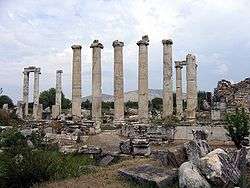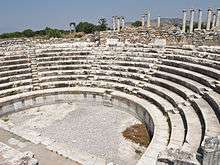Archdiocese of Stauropolis
The Archdiocese of Stauropoli (in Latin: Archidioecesis Stauropolitana) is a suppressed and titular see of the Roman Catholic Church.[1][2]
History
The Bishopric was centered on the ancient town of Stauropolis, which is identifiable with Geyre in today's Turkey,[3] is the ancient metropolitan seat of the Roman province of Caria in the civil Diocese of Asia and the Patriarchate of Constantinople.[4][5]
In the Hellenistic-Roman era, the city had the name Aphrodisia, modified in the Christian era as Stauropoli (from the Greek, meaning: city of the cross). Subsequently, in Byzantine times, the city assumed the name of Caria, a name that still resides in the village of Geyre (Geyre), built on its ruins.[6]
Stauropoli was home to an ancient Christian community. The Roman Martyrology of May 3, remember the martyrs Diodorus and Rodopiano, who were condemned to be stoned to Aphrodisias during the Diocletianic Persecution.[7]
At the Council of Chalcedon (451) bishops are signing the documents of confession as Aphrodisiadis Metropolitan Cariae. There are about thirty known bishops of Stauropoli in the first Christian millennium, many of them thanks to epigraphic and sigillografiche discoveries.
In notitiae episcopatuum of the pseudo-Epiphanius, composed during the reign of Emperor Heraclius I (about 640), the seat of Stauropoli is listed at the 20th place in the hierarchical order of metropolitanates under the patriarchate of Constantinople[8] and are attributed 28 dioceses suffragan.[9] In Notitia attributed to Emperor Leo VI (early tenth century) Stauropoli (o Caria) fell to 21st place among the metropolitanates of patriarchy,[10] and the suffragan dioceses have become 26.[11]
Today Stauropoli survives as an archbishopric holder; The seat is vacant since 19 June 1971.
Bishops
Ancient era

- Ammon (mentioned in 325)
- Eumenio (Eudocio) (mentioned in 381)
- Ciro (before 431 – after 449)
- Criton (mentioned in 451)
- Nonno (mentioned in about 488)
- Eufemio (? – 518 exiled) (monophysite bishop)
- Severiano (Stefano) † (mentioned in 553)
- Paolo (558-576 deposed) (monophysite bishop)
- Deuterio (about 577 – about 582) (single-bishop bishop)
- Teoproprio (5th–7th century)
- Ortagora (5-7th century)
- Teodorus I (mentioned in 680)
- Sisinnio (mentioned in 692)
- Eustacus (before 730 or between 787 and 815)
- Anonymous (mentioned in 787)
- Michele (8th century)

- Niceforo I (first half of 9th century)
- Teodorus II (before 861 – after 869)
- Niceforo II (mentioned in 879)
- Sergio (8th – 11th century)
- Ephraim? (11th century)
- Giuseppe (10th century)
- Anonymous (10th century)
- Giovanni I (mentioned in 997)
- Leo the Deacon (10th - 11th century)
- Eustation II (11th century)
- Anonymous (after 1025 - before 1043)
- John II (mentioned in 1030)
- Constantine (mentioned in 1032)
- Ignatius (mentioned in 1039)
- John III? (first half of the 11th century)
- Demetrius (mentioned in 1054)
Modern Era
- Diego Hortiago de Escacena (28 August 1693 – 1696)
- Aloisio Scacoz (2 December 1831 – February 22, 1842,)
- Guglielmo Massaia (August 2, 1881 – August 6, 1889)
- Francesco Domenico Reynaudi (Raynaud) (May 5, 1885 – July 24, 1893)
- Alessandro de Risio (November 30, 1896 – April 20, 1901, )
- Aurelio Zonghi (January 9, 1902 – June 27, 1902)
- Giovanni Battista Guidi (September 6, 1902 – July 22, 1904)
- Saint Guido Maria Conforti (November 14, 1904 – December 12, 1907)
- Bernard Christen (May 29, 1908 – March 11, 1909)
- Emilio Maria Miniati (April 29, 1909 – March 17, 1918)
- Ricardo Isaza y Goyechea (July 19, 1918 – June 28, 1929)
- Giovanni Battista Dellepiane (July 18, 1929 – August 13, 1961)
- Joseph Wilhelmus Maria Baeten (September 8, 1961 – August 26, 1964)
- Gabriel Thohey Mahn-Gaby (November 9, 1964 – June 19, 1971) of Rangoon)
References
- ↑ Pius Bonifacius Gams, Series episcoporum Ecclesiae Catholicae, (Leipzig, 1931), p. 447.
- ↑ Michel Le Quien, Oriens christianus in quatuor Patriarchatus digestus, (Paris, 1740), Vol.I, coll. 899-904.
- ↑ La Stauropolis at www.gcatholic.org
- ↑ Konrad Eubel, Hierarchia Catholica Medii Aevi, vol. 5, p. 363.
- ↑ Vincenzo Ruggiari, A historical Addendum to the episcopal Lists of Caria, in Revue des études byzantines, 1996, Volume54, Num54, pp. 221–234 (in particolare p. 232).
- ↑ Siméon Vailhé, v. Stauropolis, in Catholic Encyclopedia vol. XIV, (New York City, 1912).
- ↑ The Roman Martyrology. Transl. by the Archbishop of Baltimore. Last Edition, According to the Copy (Printed at Rome in 1914). Revised Edition, with the Imprimatur of His Eminence Cardinal Gibbons. Baltimore: John Murphy Company, 1916. pp. 125-126.
- ↑ Heinrich Gelzer, Ungedruckte und ungenügend veröffentlichte Texte der Notitiae episcopatuum, in: Abhandlungen der philosophisch-historische classe der bayerische Akademie der Wissenschaften, 1901, p. 534, nº 27.
- ↑ Heinrich Gelzer, Ungedruckte und ungenügend veröffentlichte Texte der Notitiae episcopatuum, in: Abhandlungen der philosophisch-historische classe der bayerische Akademie der Wissenschaften, 1901, , pp. 539-540, nnº 290-318., nº 27.
- ↑ Heinrich Gelzer, Ungedruckte und ungenügend veröffentlichte Texte der Notitiae episcopatuum, in: (Abhandlungen der philosophisch-historische classe der bayerische Akademie der Wissenschaften, 1901), p. 550, nº 24.
- ↑ Gelzer, op. cit., p. 555, nnº 344-370.